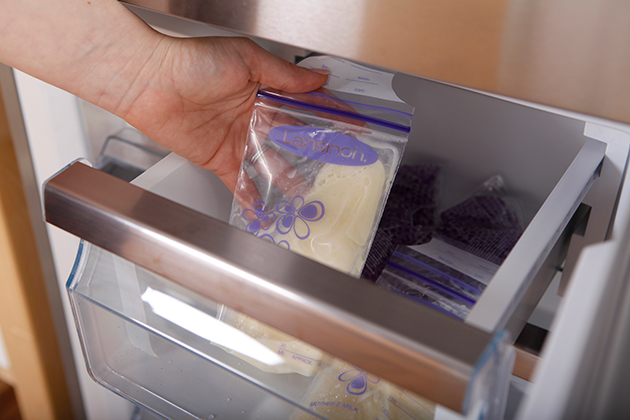Advice Articles
- Home
- Advice Articles
- Store
- Storing Expressed Breastmilk
Storing Expressed Breastmilk

Safe temperature storage guidelines
The following are guidelines from La Leche League International on how to safely store breastmilk at various temperatures:

What type of container to use
Refrigerated or frozen milk may be stored in:
- Hard-sided plastic or glass containers with well-fitting tops. Make sure you mark them with a date!
- BPA & BPS free containers, milk bags that are specifically designed for storing breastmilk, such as Lansinoh® Breastmilk Storage Bags.
Other storage tips:
- Containers or bags should not be filled to the top – leave at least one inch of space to allow the milk to expand as it freezes.
- Mark the date on the storage container. Also include your baby’s name on the label if your baby is in a nursery setting.
- If you are pumping and storing your breastmilk at work in a common refrigerator, make sure you label it with your name or put it in a bag (also marked) so it is not mistaken for regular milk.
- Keep frozen breastmilk in the middle of the freezer where the temperature is most consistent. The temperature on the sides can fluctuate and you do not want milk to partially thaw because it cannot be refrozen.
How to warm the breastmilk
- Thaw and/or heat under warm, running water or in a bowl with warm or hot water.
- Do not bring the milk to a boiling point as this will damage some nutrients.
- Gently swirl the milk before testing the temperature. Swirling will also redistribute the cream into the milk. It is normal for stored milk to separate into a cream and milk layer. Do not shake vigorously as it could damage some of the live components of breastmilk.
- Do not use a microwave oven to heat breastmilk.
How to store thawed breastmilk
- Previously frozen milk that has been thawed can be kept in the refrigerator for up to 24 hours.
- Never re-freeze breastmilk!
In very rare cases, some mothers – who have meticulously expressed and frozen their breastmilk – have discovered to their dismay that it has all spoiled. This happens when a mother produces milk that is high in lipase, the enzyme that breaks down fat in the milk. Depending upon the level, some mothers notice this rancid smell after their milk has been stored in the refrigerator; others notice it only after the milk has been frozen for a while and then thawed. Thankfully, this doesn’t happen often and can be prevented if the lipase is detected before the milk is frozen.
We suggest mums test freeze some batches and thaw them after about a week to be sure they have not spoiled. If it smells rancid, she may need to scald the milk before freezing it in the future to deactivate the lipase. For more information, refer to the Breastfeeding Answer Book published by La Leche League International.
Help is available! If you have any questions about proper breastmilk storage, talk to your Midwife or Health Visitor, or ask our Healthcare Professional.
Related Categories
Related products
-

2 in 1 Double Electric Breast Pump
Lansinoh’s 2-in-1 Electric Breast Pump is the very best option for mothers who want comfort, flexibility... View -

Single Electric Breast Pump
Lansinoh’s Single Electric Breast Pump has been designed to help you express your precious breast milk... View
